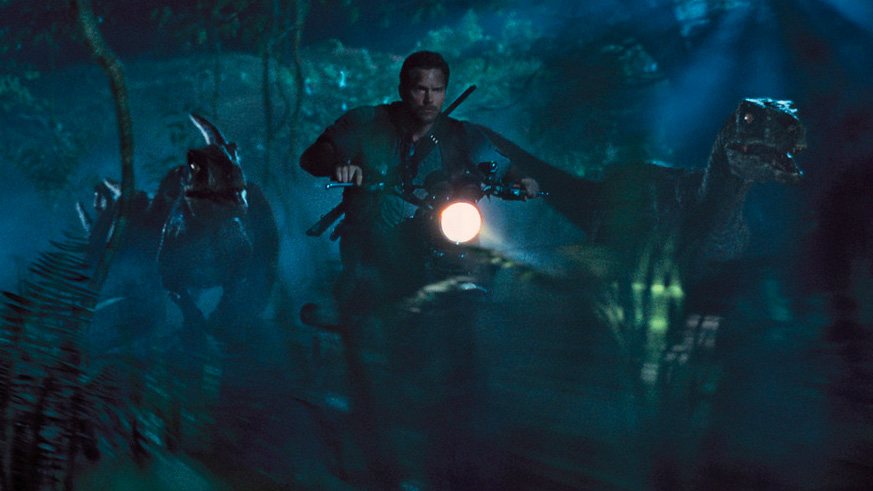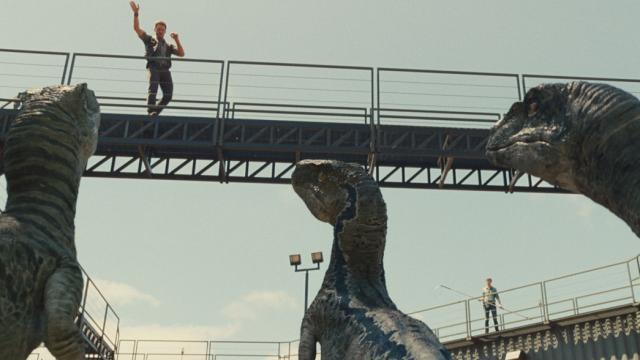Clicker training has proved effective on virtually any animal, from pigeons to porpoises to people. If you were to train a pack of raptors, it likely is the method you would use. But, Chris Pratt gets it wrong in Jurassic World; here’s how to do it right.
Spoiler Alert: There’s not going to be any serious spoilers here. But, if learning that Chris Pratt plays a tough guy who trains raptors is going to ruin the movie for you, maybe stop reading a sentence ago.
The basic concept with animal training is that you’re trying to get said creature to associate the appropriate action with a command, while building a connection in their mind that performing that action correctly means a reward. So, you ask your dog to sit, it puts its butt on the ground and you give it a piece of bacon. The dog learns not only that the word “sit” means it should sit, but that doing so is a good thing for it to do.
Animals brains aren’t quite as complex as our own, so if you consistently practice this for a decent period of time, you’ll simply form a connection between sitting and reward that compels the dog to do it from then on out. Once that’s wired into their brain, they simply do what you ask of them.
Trouble arises when you progress from simple commands — sit, stay, come — in a distraction-free environment to both more complex concepts or actions and “noisy” environments. If you want to train a dog to run to the left when you shout “left” out in the field, it’d be difficult to immediately reward the dog in a clear, immediate and confusion-free way. Did he get the bacon because he ran left or because he came back a few minutes later and acted cute?
Clicker training avoids this confusion, giving you a way to immediately and clearly communicate with the animal. A clicker can be anything that makes a “click,” but specific devices are sold that are cheap, robust and simple; you can see Pratt use one of these in the film.
Karen Pryor, who’s largely responsible for popularising the method with dog owners defines it by saying, “Clicker training is an animal training method based on behavioural psychology that relies on marking desirable behaviour and rewarding it.”

The technical terminology is “operant conditioning,” defined as, “A learning process in which the likelihood of a specific behaviour is increased or decreased through positive or negative reinforcement each time the behaviour is exhibited, so that the subject comes to associate the pleasure or displeasure of the reinforcement with the behaviour.”
In the case of animal training, you’re using the clicker to communicate a positive reinforcement immediately upon the performance of the desired action. So, if Fido runs left when he’s supposed to, you click to positively reinforce that, the second he turns left. No confusion, no delay, just a clear communication to the dog that it’s doing the right thing and that doing that right thing is good.
Of course, the animal first needs to learn to associate the click with “Oh man, I’m doing awesome!” So, you spend the first week or so creating that association by clicking and immediately giving the animal a small treat. So click, treat, click, treat, click, treat, click, treat ad infinitum until the click is indelibly associated with reward in the animal’s mind.
Karen explains, “The essential difference between clicker training and other reward-based training is that the animal is told exactly which behaviour earned it a reward. This information is communicated with a distinct and unique sound, a click, which occurs at the same time as the desired behaviour. The reward follows.”
So you do still need to give the animal a physical reward, but no longer is there confusion between action and reward. It knows it earned the ball of cheese by turning left on command.
And you see Chris Pratt do this in the early scenes of Jurassic World. It’s the one element of all this the movie gets right. After successfully calling the raptors off a pig they’re hunting, then performing a couple simple commands, he throws each of them a dead rat and praises their good behaviour.
This is actually good animal training practice. If my dog, Wiley, ever gets a little out of hand or refuses a command, I put him through a quick series of simple, basic actions that he’s known since he was a couple months old — sit and down. I reward him with praise and scratches and a treat, if I have one with me, and this helps calm him down, remind him who’s boss and reinforces that doing what I say is a positive thing for him. Pratt does the exact same with the raptors.
What the movie gets wrong is how and when the clicks are used. Rather than immediately and clearly reinforce the desired behaviour with a click, he uses the clicker to attract the raptor’s attention. It’s all wrong.
When he calls Blue off the pig, for example, he should immediately click to reinforce that stopping hunting is what he wants. Instead, he stand on the gantry and repeatedly clicks to get the dinosaurs to look at him.
Karen explains, “Without hearing a click during an action, an animal may not connect the reward with that action. Or, the animal may associate the reward with another, unwanted action. With the click, a trainer can precisely ‘mark’ behaviour so that the animal knows exactly what it was doing.”
Those multiple clicks are an additional problem for the film. “Click once (in-out),” says Karen. “If you want to express special enthusiasm, increase the number of treats, not the number of clicks.”
Karen’s website is full of great advice and methodology for positively reinforced animal training and her book, Clicker Training For Dogs is short, to the point and easy to follow.
It adapts a methodology first formally developed during WWII to train pigeons and has since been successfully applied to dolphins, whales, big cats, horses, llamas and even crocodiles. I’m sure you can see why I think it would be the training method of choice should we ever re-animate raptors, assuming they possess anything in common brain-wise with any of the above critters, it should work and it is the method preferred by animal handlers across the world.
My own experience in clicker training Wiley was mixed. He’s a well-intentioned dog that’s incredibly loyal and who won’t go more than 100 yards from my side, but we’ve always had more of a father-son relationship than the master-slave I observe with most well-disciplined dogs. There’s a little more self-determination involved than is typical.
He knows all the usual commands and picked them up remarkably easily, but his primary motivation is play, which can be hard to apply as a reinforcement. If we’re already playing, how do I supply sufficient reward? He cares more about wrestling than he does about a chicken liver.

Anyone with enough experience on a motorcycle to ride one through the jungle at night while keeping up with a pack of raptors would also know, through experience, how much crashing hurts. As ridiculous as it is to presume real world stuff in a film about re-animated dinosaurs, Pratt wouldn’t be on the bike without a helmet, body armour, gloves and boots in this circumstance.
When I tried clicker training, it proved relatively straight forward. After all, the basic premise is simply: “Get the behaviour, mark the behaviour, reinforce the behaviour.” Our trouble was two-fold: 1) the association between the click and food is not Wiley’s primary motivation and not a most-valuable reward, so it can be overruled in his mind and 2) I found it inconvenient to use the clicker in the real world.
I suppose I could address the first with some sort of click-play association, but it’s really the second that halted this method for us. Wiley is my partner on adventures and we do a fairly tough hike for daily exercise and training. Doing that stuff, my hands are frequently too busy to hold a clicker and he’s often further away from me than the noise of the clicker will travel. I simply found it easier to use my voice to pursue the same method. With that, I moulded a fairly well-trained little beast.
And, through positive reward, mental stimulation, plenty of exercise and strong leadership, one that’s confident, friendly and predictable. That’s the part of the raptor training in Jurassic World that looks most familiar to me; that Pratt is able to form a relationship with the raptors where he’s an undisputed and also loved leader comes off as totally believable. It’s unquestionable in my mind that Wiley would attack Indominous Rex should she ever threaten me.
